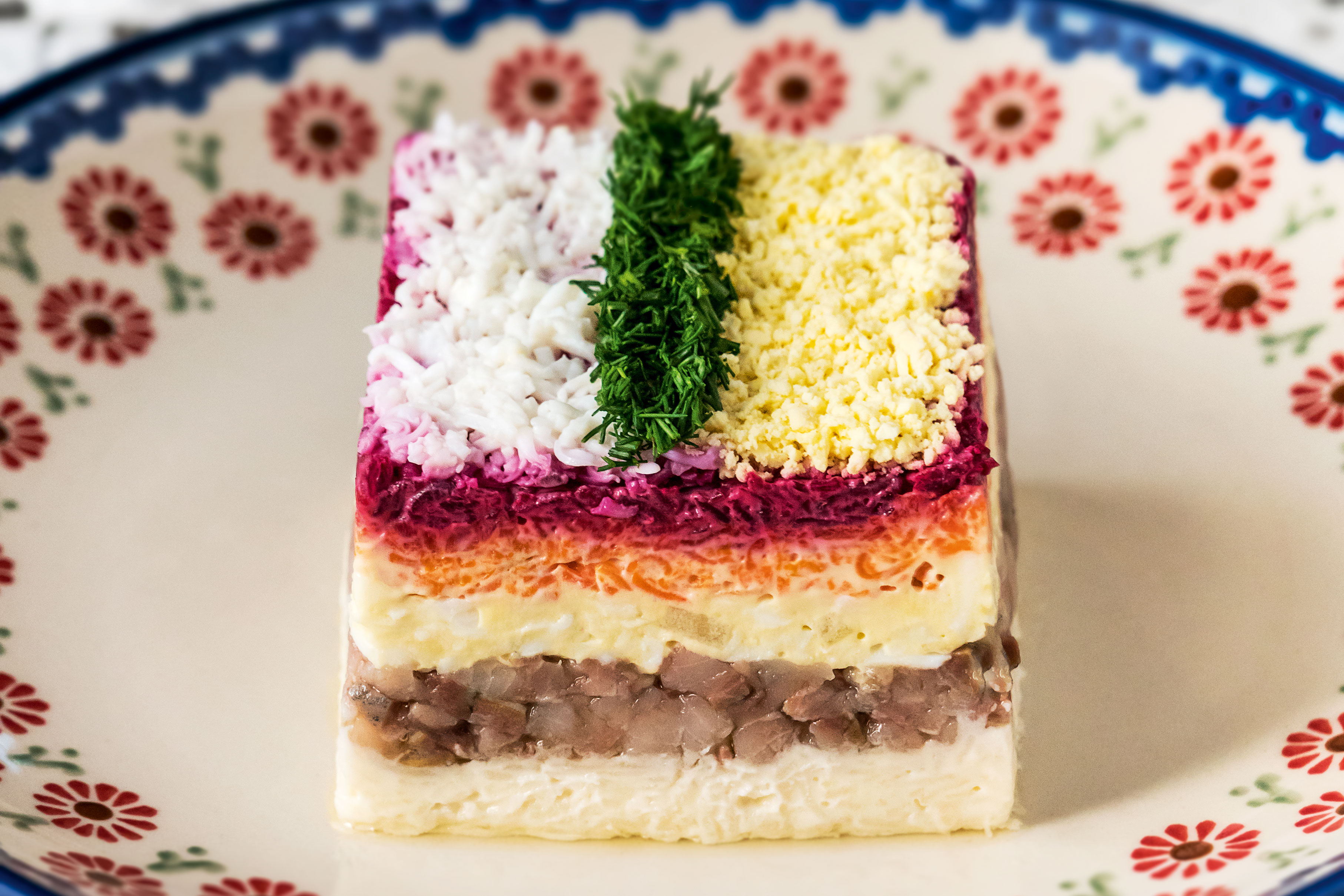Food columnist Natalia Golumb explains how this unique and idiosyncratic Soviet delicacy, the shuba salad, has become a staple of the New Year feast table: a salad with its very own ‘fur’ coat
The most colourful salad on the Azeri New Year table, it is simply impossible to imagine a New Year’s evening without it. I’m talking, of course, about Shuba – a salty, sweet, sour and fresh salad bound together by a hefty dose of mayonnaise. However, with its array of colours, ingredients and flavours, is better known as “Herring Under a Fur Coat”.
When exactly shuba was born is not known. But even in the 19th century, dishes with similar layers of herring and vegetables were found in Scandinavian, English and German cuisines. In Azerbaijan, the dish – and its festive role – has its origins in our Soviet period. Today it has become so quintessentially Azerbaijani that every woman thinks her salad, made with all her own tricks and secrets, is of course the best. This is understandable, for the way in which shuba is assembled is an art, and it looks more like a cake than a salad.
I personally love to play with new flavour combinations, for example, to change habitual textures by turning soft beets into crispy chips or tender jelly. So here I have decided to share with you a ‘traditional’ recipe (honed with my own secrets), as well as a more sophisticated method to create a shuba that is truly a piece of art!
Traditional Shuba: Herring under A Fur Coat with apples and homemade mayonnaise
You will need:
For the salad:
1 kg potatoes
1 kg carrots
1 kg beetroot
4 apples
1 kg salty or marinated herring
8 eggs
3 small shallots, finely chopped
Handful chives, finely chopped, to taste
Dill, finely chopped, to taste
For the mayonnaise:
2 tablespoons mustard
4 egg yolks
White pepper, to taste
2 cups olive or grapeseed oil
Salt and black pepper, to taste
Serves six to eight
First, boil the potatoes, beetroots, carrots and eggs (separately, or everything will come out purple!).
While this is happening, make the mayonnaise: Blend the mustard with the egg yolks in a food processor, add a pinch of salt and white pepper and gradually add the oil little by little. The mixture will start to thicken. At the end, add a little lemon juice to taste.
Once you have made your mayonnaise, set aside and prepare your apples. Cut them into small cubes, add to the mayonnaise, and then throw in your chopped shallots, chives and dill. Peel your boiled potatoes, grate them, and add them too to the mayonnaise mixture, along with salt and white pepper. Mix well.
Cut the herring into small cubes or slices.
Slice your boiled carrots, potatoes and beetroots and set them into three bowls – add a little bit of the mayonnaise mixture to each, and mix gently.
Now for the assembly!
To make small and elegant round portions lay the carrots in the ring, then the herring, and continue with the potatoes, then another layer of herring and, finally, finish with the beets.
Decorate your salad portions with finely chopped chives, though you can also sprinkle around some pomegranate seeds if you want.
Sophisticated Shuba: Mackerel under A Fur Coat
For the salad:
300 grams fresh mackerel fillets
1 litre water
Sprig of watercress
250 grams beetroot
50 millilitres beetroot juice
Small red onion
5 milliliters apple cider vinegar
5 grams gelatin
10 grams sugar
45 grams fine salt
For the beetroot cream:
1 egg, boiled
200 grams good quality mayonnaise
50 grams apple
10 grams whole grain mustard
Serves two
Begin by preparing the mackerel: make sure they are skinless, and then prepare them in a saline solution. Do this by boiling the water, adding 30 grams of salt and a little sugar. Immerse the fish in the solution for no longer than half an hour. Remove and drain and set aside.
Then, prepare the gelatin as per the instructions on the packet – so soak it in cold water, and then add to warm water until dissolved. Take your fish, and paint the gelatin solution onto the fillets in generous portions. Making sure you’ve covered them completely, overlay the fillets together so each edge overlaps the other, and then roll it all into one big cylinder shape (rather like a roulade). Chill in the refrigerator for two hours. Once chilled, it should have a lovely shine from the gelatin. Now slice the roll to create discs. They should be about 40 grams each (so roughly eight pieces).
While the fish is chilling, you can make the beetroot cream: Carefully combine 50 grams of boiled beets with the boiled egg (both finely chopped) as well as the mayonnaise. Add the diced apple and the mustard. Season to taste with salt and put it into a piping bag with a fairly wide nozzle.
Pickle the onion: peel the onion, cut into quarters to create ‘boats’ and separate the layers with a knife. Place in a pan and add some water, the beet juice, apple cider vinegar and about 5 grams of salt. Bring to a boil. Leave the onions in this beetroot broth to infuse – best if overnight in the refrigerator.
Beetroot chips: Take 100 grams of the raw beetroot and cut on a mandolin grater with a corrugated nozzle. Blanch in salted water. Dry on paper and deep-fry at 140 degrees. Finally, dry your chips in a dehydrator – about three hours.
Beetroot powder: Take another 100 grams of your raw beetroot, slice it thinly, and place it in the dehydrator at 60 degrees centigrade for 24 hours. It should now be completely dry and brittle. Chop it up as finely as possible and then press through a sieve. Store in an airtight container.
Finally, to serve! Place our mackerel piece onto a place. Squeeze the beetroot cream in a circle around it. Arrange your marinated onion ‘boats’, beet crisps and some cress on top. Finally, sprinkle with the beet powder (through a sieve, for best results).
Bon appetite!
Serve this with red wine (and only red wine!), the one you love most…
Image courtesy of Richard Haughton




